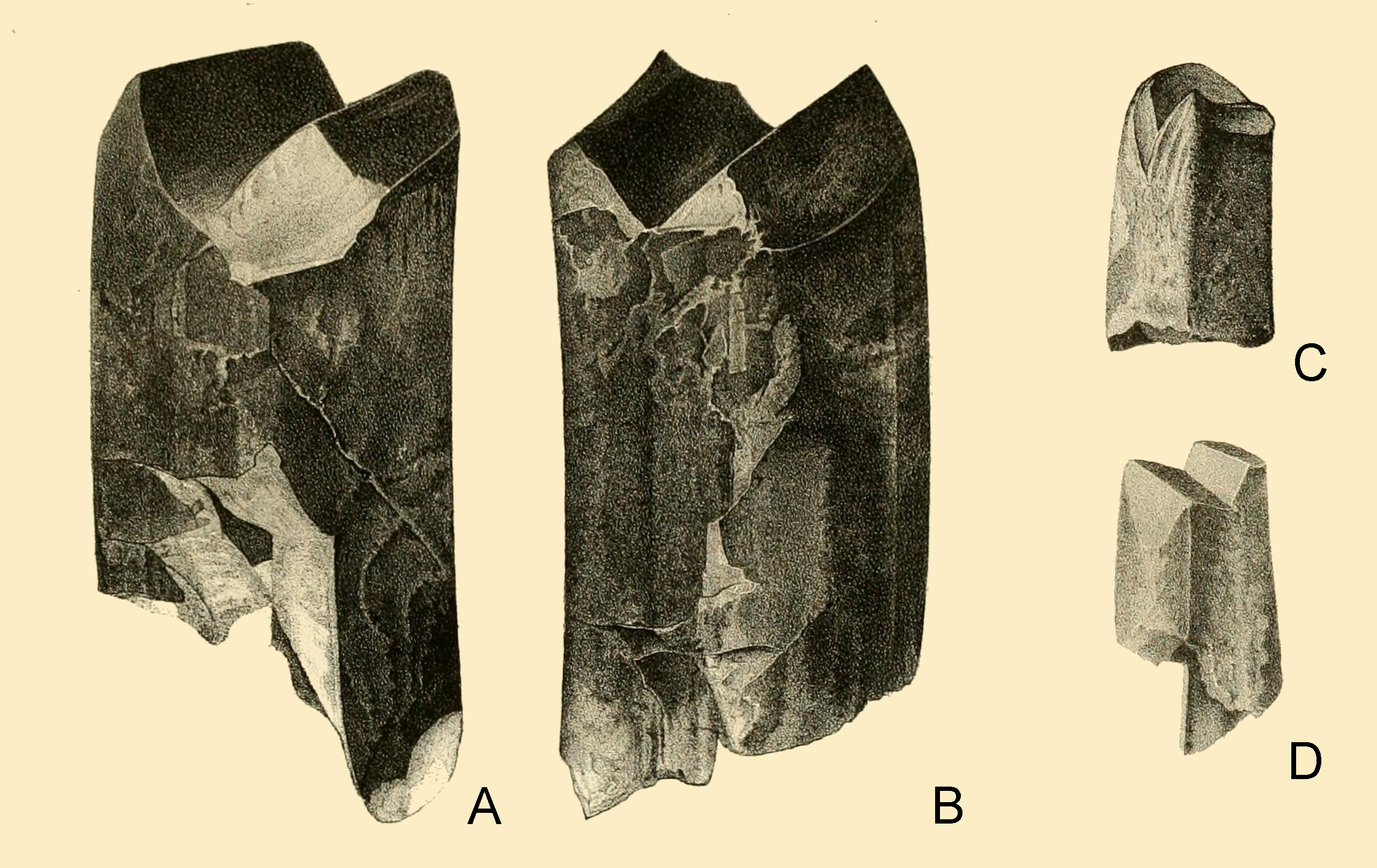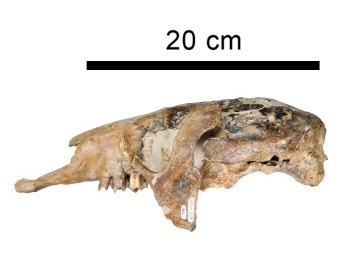|
Megatheriidae
Megatheriidae is a family of Extinction, extinct ground sloths that lived from approximately 23 Annum, mya—11,000 years ago. Megatheriids appeared during the Oligocene, Late Oligocene (Deseadan in the South American land mammal age, SALMA classification), some 29 million years ago, in South America. The group includes the largest known ground sloths, the elephant sized ''Megatherium'' (given its name 'great beast' by Georges Cuvier) and ''Eremotherium''. An early genus that was originally considered a megatheriid, the more slightly built ''Hapalops'', reached a length of about . The nothrotheres have recently been placed in their own family, Nothrotheriidae. The skeletal structure of these ground sloths indicates that the animals were massive. Their thick bones and even thicker joints (especially those on the hind legs) gave their appendages tremendous power that, combined with their size and fearsome claws, provided a formidable defense against predators. The earliest megat ... [...More Info...] [...Related Items...] OR: [Wikipedia] [Google] [Baidu] |
Eremotherium
''Eremotherium'' (from Greek for "steppe" or "desert" "beast": ἔρημος "steppe or desert" and θηρίον "beast") is an extinct genus of giant ground sloth in the family Megatheriidae. ''Eremotherium'' lived in southern North America, Central America, and northern South America. It was one of the largest sloths, with a body size comparable to elephants, weighing around and measuring about long, slightly larger than its close relative ''Megatherium''. Originating during the Pliocene, ''Eremotherium'' migrated northwards into North America as part of the Great American Interchange of fauna between North and South America following the emergence of the Isthmus of Panama during the late Pliocene. Finds of ''Eremotherium'' are common and widespread, with fossils being found as far north as South Carolina (with a single record also reported from New Jersey) in the United States and as far south as Rio Grande Do Sul in southern Brazil, and many complete skeletons have been unea ... [...More Info...] [...Related Items...] OR: [Wikipedia] [Google] [Baidu] |
Megatherium
''Megatherium'' ( ; from Greek () 'great' + () 'beast') is an extinct genus of ground sloths endemic to South America that lived from the Early Pliocene through the end of the Late Pleistocene. It is best known for the elephant-sized type species ''Megatherium americanum'', primarily known from the Pampas, but ranging southwards to northernmost Patagonia and northwards to southern Bolivia during the late Middle Pleistocene and Late Pleistocene. Various other species belonging to the subgenus ''Pseudomegatherium'' ranging in size comparable to considerably smaller than ''M. americanum'' are known from the Andean region. The first (holotype) specimen of ''Megatherium'' was discovered in 1787 on the bank of the Luján River in what is now northern Argentina. The specimen was then shipped to Spain the following year wherein it caught the attention of the French paleontologist Georges Cuvier, who named the animal in 1796 and was the first to determine, by means of comparative anato ... [...More Info...] [...Related Items...] OR: [Wikipedia] [Google] [Baidu] |
Ground Sloth
Ground sloths are a diverse group of extinct sloths in the mammalian superorder Xenarthra. They varied widely in size with the largest, belonging to genera '' Lestodon'', ''Eremotherium'' and ''Megatherium'', being around the size of elephants. Ground sloths represent a paraphyletic group, as living tree sloths are thought to have evolved from ground sloth ancestors. The early evolution of ground sloths took place during the late Paleogene and Neogene of South America, while the continent was isolated. At their earliest appearance in the fossil record, they were already distinct at the family level. Sloths dispersed into the Greater Antilles during the Oligocene, and the presence of intervening islands between the American continents in the Miocene allowed a dispersal of some species into North America. They were hardy as evidenced by their high species diversity and their presence in a wide variety of environments, extending from the far south of Patagonia ( Cueva del Milodón ... [...More Info...] [...Related Items...] OR: [Wikipedia] [Google] [Baidu] |
Megatheriinae
Megatheriinae is a subfamily of the Megatheriidae, an extinct family of ground sloths that lived from the Middle Miocene to the Early Holocene. Classification Within the Megatheriidae there are two (possibly three) subfamilies; the Megatheriinae and the Planopsinae. The phylogenetically older group is represented by the Planopsinae from the Lower and Middle Miocene. These still possessed a caniniform anterior tooth, which was separated from the posterior molar-like teeth by a small diastema . The more derived Megatheriinae, which are known from the Middle Miocene to the Early Holocene, on the other hand, had fully homodontic molars in a closed row. Originally, the subfamilies of the Nothrotheriinae and the Schismotheriinae were also placed in the Megatheriidae. Based on skull studies, the Nothrotheriidae, in which, among other genera, '' Nothrotherium'', '' Nothrotheriops,'' and the semiaquatic ''Thalassocnus ''Thalassocnus'' is an extinct genus of semiaquatic ground sloths fr ... [...More Info...] [...Related Items...] OR: [Wikipedia] [Google] [Baidu] |
Thalassocnus
''Thalassocnus'' is an extinct genus of semiaquatic ground sloths from the Miocene and Pliocene of the Pacific South American coast. It is monotypic within the subfamily Thalassocninae. The five species—''T. antiquus'', ''T. natans'', ''T. littoralis'', ''T. carolomartini'', and ''T. yuacensis''—represent a chronospecies, a population gradually adapting to marine life in one direct lineage. They are the only known aquatic sloths, but they may have also been adapted to a terrestrial lifestyle. They have been found in the Pisco Formation of Peru, the Tafna Formation of Argentina, and the Bahía Inglesa Formation, Bahía Inglesa, Coquimbo Formation, Coquimbo, and Horcón Formation, Horcón formation (geology), formations of Chile. Thalassocninae has been placed in both the family (biology), families Megatheriidae and Nothrotheriidae. ''Thalassocnus'' evolved several marine adaptations over 4 million years, such as dense and heavy bones to counteract buoyancy, the internal nostri ... [...More Info...] [...Related Items...] OR: [Wikipedia] [Google] [Baidu] |
Sibotherium
''Sibotherium'' is an extinct genus of ground sloth in the family Megatheriidae that lived in what is now Costa Rica during the Late Miocene. It was a large ground sloth, weighing more than 2,500 kg. Discovery Fossils of ''Sibotherium'' have been found in the Curré Formation in the Puntarenas Province of Costa Rica. The finds are 5.8 million years old and date to the Late Hemphillian, falling within the Late Miocene. The holotype is a left ankle bone. Skeletal parts of some individuals of ''Sibotherium'' have also been found, namely partial mandibles, molars, a collarbone and parts of the legs, hands and feet. Etymology The genus name, ''Sibotherium'' is derived from ''Sibö'', the good creator in Bribri mythology, and ''therion'', Greek for "beast". In the beginning Sibö made the Earth, the land, the animals and the plants according to the myths of the Bribri, the original inhabitants of southern Costa Rica. This name was chosen because ''Sibotherium'' was one of ... [...More Info...] [...Related Items...] OR: [Wikipedia] [Google] [Baidu] |
Nothrotheriidae
Nothrotheriidae is a family of extinct ground sloths that lived from approximately 17.5 mya—10,000 years ago, existing for approximately . Previously placed within the tribe Nothrotheriini or subfamily Nothrotheriinae within Megatheriidae, they are now usually placed in their own family, Nothrotheriidae. Nothrotheriids appeared in the Burdigalian, some 19.8 million years ago, in South America. The group includes the comparatively slightly built '' Nothrotheriops'', which reached a length of about . While nothrotheriids were small compared to some of their megatheriid relatives, their claws provided an effective defense against predators, like those of larger anteaters today. Evolution During the late Miocene and Pliocene, the sloth genus ''Thalassocnus'' of the west coast of South America became adapted to a shallow-water marine lifestyle. However, the family placement of ''Thalassocnus'' has been disputed; while long considered a nothrotheriid, one 2017 analysis moves it to M ... [...More Info...] [...Related Items...] OR: [Wikipedia] [Google] [Baidu] |
Prepoplanops
''Prepoplanops'' is an extinct genus of ground sloth of the family Megatheriidae. It lived in the Miocene around 18 to 16 million years ago of what is now Argentina Argentina, officially the Argentine Republic, is a country in the southern half of South America. It covers an area of , making it the List of South American countries by area, second-largest country in South America after Brazil, the fourt .... The only known species is ''Prepoplanops boleadorensis''. Description ''Prepoplanops'' was a medium-sized ground sloth, about 1.5 to 2 meters long. Classification ''Prepoplanops'' was a representative of the Planopsinae, a subfamily of megatheriids that lived during the Miocene. In particular, it appears that ''Prepoplanops'' was an intermediate form between ''Planops'' and ''Prepotherium''. ''Prepoplanops boleadorensis'' was first described in 2013, based on fossil remains found in Argentina's Santa Cruz Province in the Cerro Boleadoras Formation. Below is a phyl ... [...More Info...] [...Related Items...] OR: [Wikipedia] [Google] [Baidu] |
South American Land Mammal Age
The South American land mammal ages (SALMA) establish a geologic timescale for prehistoric South American fauna beginning 64.5 Ma during the Paleocene and continuing through to the Late Pleistocene (0.011 Ma). These periods are referred to as ages, stages, or intervals and were established using geographic place names where fossil materials where obtained.Flynn & Swisher, 1995 The basic unit of measurement is the first/last boundary statement. This shows that the first appearance event of one taxon is known to predate the last appearance event of another. If two taxa are found in the same fossil quarry or at the same stratigraphic horizon, then their age-range zones overlap. Background South America was an island continent for much of the Cenozoic, or the "Age of Mammals". As a result, its mammals evolved in their own unique directions, as Australia and Madagascar still have today. Paleogeographic timeline A simplified paleogeographic timeline of South America: * 66 Ma – ... [...More Info...] [...Related Items...] OR: [Wikipedia] [Google] [Baidu] |
Bone
A bone is a rigid organ that constitutes part of the skeleton in most vertebrate animals. Bones protect the various other organs of the body, produce red and white blood cells, store minerals, provide structure and support for the body, and enable mobility. Bones come in a variety of shapes and sizes and have complex internal and external structures. They are lightweight yet strong and hard and serve multiple functions. Bone tissue (osseous tissue), which is also called bone in the uncountable sense of that word, is hard tissue, a type of specialised connective tissue. It has a honeycomb-like matrix internally, which helps to give the bone rigidity. Bone tissue is made up of different types of bone cells. Osteoblasts and osteocytes are involved in the formation and mineralisation of bone; osteoclasts are involved in the resorption of bone tissue. Modified (flattened) osteoblasts become the lining cells that form a protective layer on the bone surface. The mine ... [...More Info...] [...Related Items...] OR: [Wikipedia] [Google] [Baidu] |





